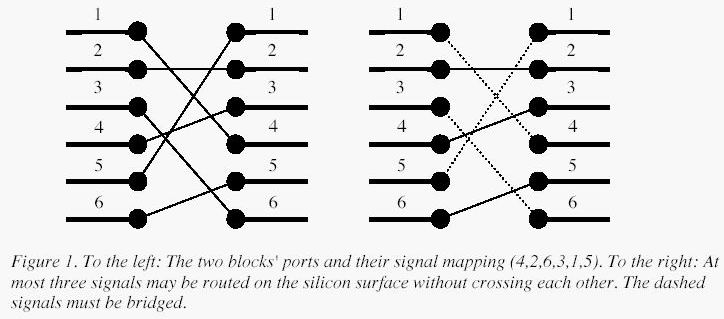POJ 1631 Bridging signals LIS(最长递增子序列) +nlogn算法+二分查找
2010-12-16 11:32
232 查看
本题就是求最长递增子序列的长度,用动态规划
Bridging signals
| Time Limit: 1000MS | Memory Limit: 10000K | |
'Oh no, they've done it again', cries the chief designer at the Waferland chip factory. Once more the routing designers have screwed up completely, making the signals on the chip connecting the ports of two functional blocks cross each other all over the place. At this late stage of the process, it is too expensive to redo the routing. Instead, the engineers have to bridge the signals, using the third dimension, so that no two signals cross. However, bridging is a complicated operation, and thus it is desirable to bridge as few signals as possible. The call for a computer program that finds the maximum number of signals which may be connected on the silicon surface without crossing each other, is imminent. Bearing in mind that there may be thousands of signal ports at the boundary of a functional block, the problem asks quite a lot of the programmer. Are you up to the task?

A typical situation is schematically depicted in figure 1. The ports of the two functional blocks are numbered from 1 to p, from top to bottom. The signal mapping is described by a permutation of the numbers 1 to p in the form of a list of p unique numbers in the range 1 to p, in which the i:th number specifies which port on the right side should be connected to the i:th port on the left side.Two signals cross if and only if the straight lines connecting the two ports of each pair do.
Input
On the first line of the input, there is a single positive integer n, telling the number of test scenarios to follow. Each test scenario begins with a line containing a single positive integer p < 40000, the number of ports on the two functional blocks. Then follow p lines, describing the signal mapping:On the i:th line is the port number of the block on the right side which should be connected to the i:th port of the block on the left side.
Output
For each test scenario, output one line containing the maximum number of signals which may be routed on the silicon surface without crossing each other.
Sample Input
4 6 4 2 6 3 1 5 10 2 3 4 5 6 7 8 9 10 1 8 8 7 6 5 4 3 2 1 9 5 8 9 2 3 1 7 4 6
Sample Output
3 9 1 4
这是刚刚开始写的O(N^2)算法,提交后TLE
/* Author yan
*POJ 1631
*Bridging signals
*/
#include<stdio.h>
int opt[40000];
int n;
int value[40000];
int main()
{
int i,j;
int test_case;
int max;
freopen("input","r",stdin);
scanf("%d",&test_case);
while(test_case--)
{
scanf("%d",&n);
memset(opt,0,sizeof(opt));
max=-1;
for(i=0;i<n;i++) scanf("%d",&value[i]);
for(i=0;i<n;i++)
{
opt[i]=1;
for(j=0;j<i;j++)
{
if(value[i]>value[j]&&opt[i]<opt[j]+1) opt[i]=opt[j]+1;
}
if(max<opt[i]) max=opt[i];
}
printf("%d/n",max);
}
return 0;
}看到网上的的优化,时间复杂度优化成O(N*logN)
/* Author yan
*POJ 1631
*Bridging signals
*/
#include<stdio.h>
#define MAX 40000
int n;
int value[MAX];///记录原始数组
int opt[MAX+1];///记录长度为k的最长递增序列的结尾元素,下标从1开始
//int len[MAX];///记录以value[k]结尾的最长递增子序列的长度
int LIS(const int value[],const int n)
{
int i,j;
int size=1;
opt[1]=value[0];
//len[0]=1;
for(i=1;i<n;i++)
{
if(value[i]<=opt[1]) j=1;//<=换为<
else if(value[i]>opt[size]) j=++size;// > 换为: >=
else j=binary_search(opt,size,value[i]);
//printf("j=%d/n",j);
opt[j]=value[i];
//len[i]=j;
}
return size;
}
int binary_search(const int opt[],const int size,const int value)
{
int left=1;
int right=size;
int mid;
while(left<=right)
{
mid=(left+right)/2;
if(value==opt[mid]) return mid;
else if(value>opt[mid] && value<=opt[mid+1]) return mid+1;// >&&<= 换为: >= && <
else if(value<opt[mid]) right=mid-1;
else left=mid+1;
}
}
int main()
{
int i,j;
int test_case;
int max;
//freopen("input","r",stdin);
scanf("%d",&test_case);
while(test_case--)
{
scanf("%d",&n);
//memset(opt,0,sizeof(opt));
for(i=0;i<n;i++) scanf("%d",&value[i]);
printf("%d/n",LIS(value,n));
}
return 0;
}
相关文章推荐
- POJ 1631 Bridging signals LIS(最长递增子序列) +nlogn算法+二分查找
- POJ_1631_Bridging_Signals_(动态规划,LIS)
- poj 1631(Bridging signals LIS)nlogn
- poj 1631 Bridging signals dp LIS
- poj 1631 Bridging signals LIS 最长非递减子序列
- POJ-1631 Bridging signals LIS
- poj1631 Bridging signals
- poj 1631--Bridging signals
- POJ 1631 Bridging signals & 2533 Longest Ordered Subsequence
- poj 1631 Bridging signals
- 刷题——Bridging signals POJ - 1631
- POJ 1631 Bridging signals DP(最长上升子序列)
- POJ 1631 Bridging signals (LIS:最长上升子序列)
- poj 1631 || hdu 1950 Bridging signals(动态规划:LIS)
- poj 1631 nologn LIS
- POJ 1631 Bridging signals(LIS 二分 快速方法)
- POJ 1631 Bridging signals(LIS:最长上升子序列)
- POJ 1631 Bridging signals(LIS)
- POJ1631 动态规划 LIS
- POJ 1631 nlogn求LIS
